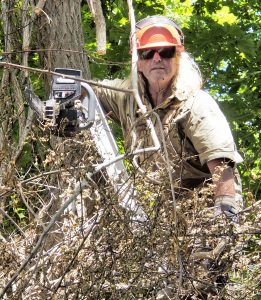By CARRIE GENTILE
An unlucky day of clearing brush in the backyard can lead to rashes, blisters, even swelling, that, in severe cases, requires steroids. The culprit is poison ivy, the ubiquitous and flourishing plant found in backyards, pastures, road sides, along river streams, fences, parks, beaches or in a wooded forest.
Jesse Hamilton of Hamilton Trees said he has treated more poison ivy this year than in the past, finding it prevalent along the beaches.
“It’s virulent this year,” echoed Jude Wilber of Invasive Vine Solutions.
Common advice from local landscapers and gardeners is that identification is most important when coping with it, and it may not be as simple as the rhyme, “leaves of three, let them be.”

There are many treatments on the market, as well as home remedies, for the rash caused by poison ivy.
In general, the plant grows as a vine or shrub and appears in clusters of three non-serrated pointed leaflets, producing white berries in late summer. Much of the time the leaves have a sheen, but it is not always the case. Autumn weather turns the dark green leaves a reddish, rusty color, said Reginald Soares of MR Soares Nursery and Landscape in East Falmouth.
The itch-inducing ingredient is called urushiol, an oil that’s contained in the plant’s leaves, stems, and roots. Urushiol sticks to anything it touches, even pets.
“If you get it bad enough once, you’ll learn quickly how to identify it,”Mr. Hamilton said, recounting a bad breakout when he was 11 that made him aware of what to watch for.
At the beginning of each landscaping season, he hands out a pamphlet to his landscaping staff with identification and treatment information for both sumac and ivy.
“It’s tough because it can appear in many colors and shapes. It is not always shiny and can have jagged edges.
“If there’s any doubt, stay away,” he said.
The handout is created by a company called Zanfel that manufactures a poison ivy, oak, sumac wash that removes urushiol. Mr. Hamilton testifies the product works well at reducing swelling and rash. And the company’s website, www.zanfel.com, contains useful educational information on the plants and even has a downloadable PDF poster of the poisonous varieties.
For larger infestations, most landscapers and lawn maintenance companies will get rid of the plants for property owners by either pulling them from the roots or by spot-spraying an herbicide like Round-Up.
 Mr. Wilber spends his days in thick brush and woods on commercial-scale jobs, clearing lots of bittersweet that have serpentined around tree trunks. He said over 50 percent of the work calls involve poison ivy removal, and he does it without chemicals.
Mr. Wilber spends his days in thick brush and woods on commercial-scale jobs, clearing lots of bittersweet that have serpentined around tree trunks. He said over 50 percent of the work calls involve poison ivy removal, and he does it without chemicals.
Mr. Wilber said spraying the leaves works for small infestations or will control the growth for a while, but to eradicate it, you must dig down and remove the rhizomes, or mass of roots. It’s the epicenter and it sends out roots and shoots from its nodes, creating plentiful offspring and more shrubs.
It’s not an easy task and usually requires trampling through heavy brush, in the thick of summer, fully dressed in pants and long sleeves, with axes and other hardy tools. The vines can grow thick and woody and require manpower.
An upcoming job, he said, will require him to don a head-to-toe Tyvek jumpsuit to ensure safety from the plants.
Common advice for homeowners who want to get rid of the plants on their own is to use a poison ivy herbicide found at any garden center or hardware store, and spot spray the leaves, being careful to avoid any other surrounding plants. Once the poison gets into the leaves, it eventually makes it way down the system and kills the plant, usually within three days.
Mr. Soares said you may have to spray twice to get at the layer under the top canopy. You can uproot the plants carefully, but never cut the plants as the urushiol will seep out, or even worse, it will spur further growth.
Organic options, he said, include using vinegar on the leaves or hiring goats to eat the plants, an up and coming method that is gaining in popularity.
Kate Sullivan, owner of Sleeping Bee Gardens, suggests smothering any new growth sprouting in a garden by placing cardboard down and covering it with wet mulch until the plant suffocates and dies.
Highly allergic to poison ivy herself, Ms. Sullivan warns others to proceed with caution while working with the plants. Always wear gloves, long sleeve and pants, and wash it all in hot soapy water separately. Don’t forget to wipe off the urushiol off your tools as well.

